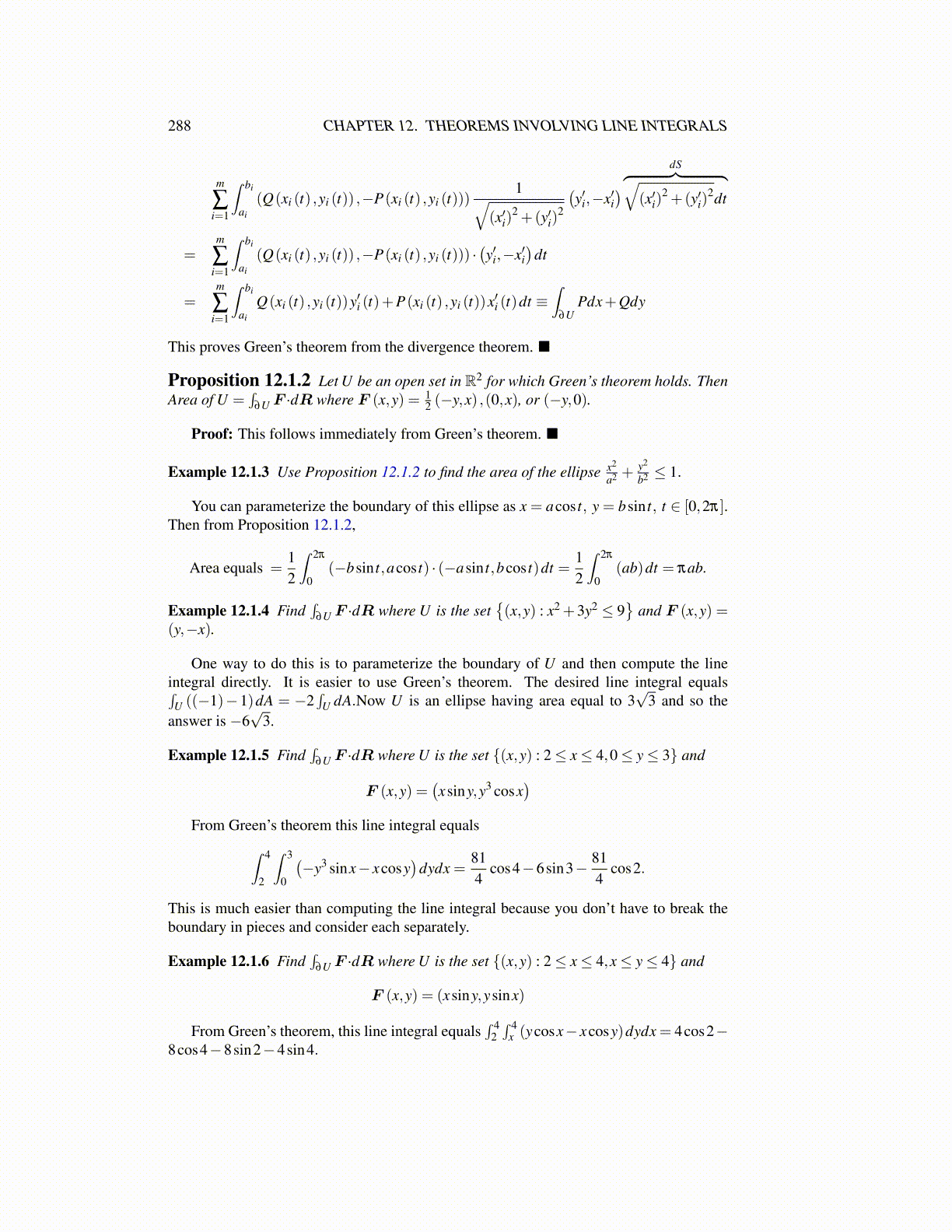
288 CHAPTER 12. THEOREMS INVOLVING LINE INTEGRALS
m
∑i=1
∫ bi
ai
(Q(xi (t) ,yi (t)) ,−P(xi (t) ,yi (t)))1√
(x′i)2 +(y′i)
2
(y′i,−x′i
) dS︷ ︸︸ ︷√(x′i)
2 +(y′i)2dt
=m
∑i=1
∫ bi
ai
(Q(xi (t) ,yi (t)) ,−P(xi (t) ,yi (t))) ·(y′i,−x′i
)dt
=m
∑i=1
∫ bi
ai
Q(xi (t) ,yi (t))y′i (t)+P(xi (t) ,yi (t))x′i (t)dt ≡∫
∂UPdx+Qdy
This proves Green’s theorem from the divergence theorem. ■
Proposition 12.1.2 Let U be an open set in R2 for which Green’s theorem holds. ThenArea of U =
∫∂U F ·dR where F (x,y) = 1
2 (−y,x) ,(0,x), or (−y,0).
Proof: This follows immediately from Green’s theorem. ■
Example 12.1.3 Use Proposition 12.1.2 to find the area of the ellipse x2
a2 +y2
b2 ≤ 1.
You can parameterize the boundary of this ellipse as x = acos t, y = bsin t, t ∈ [0,2π].Then from Proposition 12.1.2,
Area equals =12
∫ 2π
0(−bsin t,acos t) · (−asin t,bcos t)dt =
12
∫ 2π
0(ab)dt = πab.
Example 12.1.4 Find∫
∂U F ·dR where U is the set{(x,y) : x2 +3y2 ≤ 9
}and F (x,y) =
(y,−x).
One way to do this is to parameterize the boundary of U and then compute the lineintegral directly. It is easier to use Green’s theorem. The desired line integral equals∫
U ((−1)−1)dA = −2∫
U dA.Now U is an ellipse having area equal to 3√
3 and so theanswer is −6
√3.
Example 12.1.5 Find∫
∂U F ·dR where U is the set {(x,y) : 2≤ x≤ 4,0≤ y≤ 3} and
F (x,y) =(xsiny,y3 cosx
)From Green’s theorem this line integral equals∫ 4
2
∫ 3
0
(−y3 sinx− xcosy
)dydx =
814
cos4−6sin3− 814
cos2.
This is much easier than computing the line integral because you don’t have to break theboundary in pieces and consider each separately.
Example 12.1.6 Find∫
∂U F ·dR where U is the set {(x,y) : 2≤ x≤ 4,x≤ y≤ 4} and
F (x,y) = (xsiny,ysinx)
From Green’s theorem, this line integral equals∫ 4
2∫ 4
x (ycosx− xcosy)dydx = 4cos2−8cos4−8sin2−4sin4.